Stakeholder Identification and Engagement at Hilton Sydney Hotel
VerifiedAdded on 2020/03/23
|11
|1910
|73
Report
AI Summary
This report examines stakeholder identification and engagement strategies for the Hilton Sydney hotel, focusing on environmental issues and waste management. It identifies key stakeholders, including the local community, society, government, and suppliers. The report analyzes the hotel's approach to reducing greenhouse gas emissions, improving waste management (particularly food waste), and addressing climate change impacts. It applies the Clifton Model for stakeholder analysis, emphasizing the importance of creating value for all stakeholders, not just shareholders. Recommendations include carbon offsetting, engaging employees and customers in waste reduction, and promoting renewable energy use. The report highlights the significance of Corporate Social Responsibility and long-term sustainability for the hotel's success, emphasizing the need to address environmental concerns and create value for stakeholders.
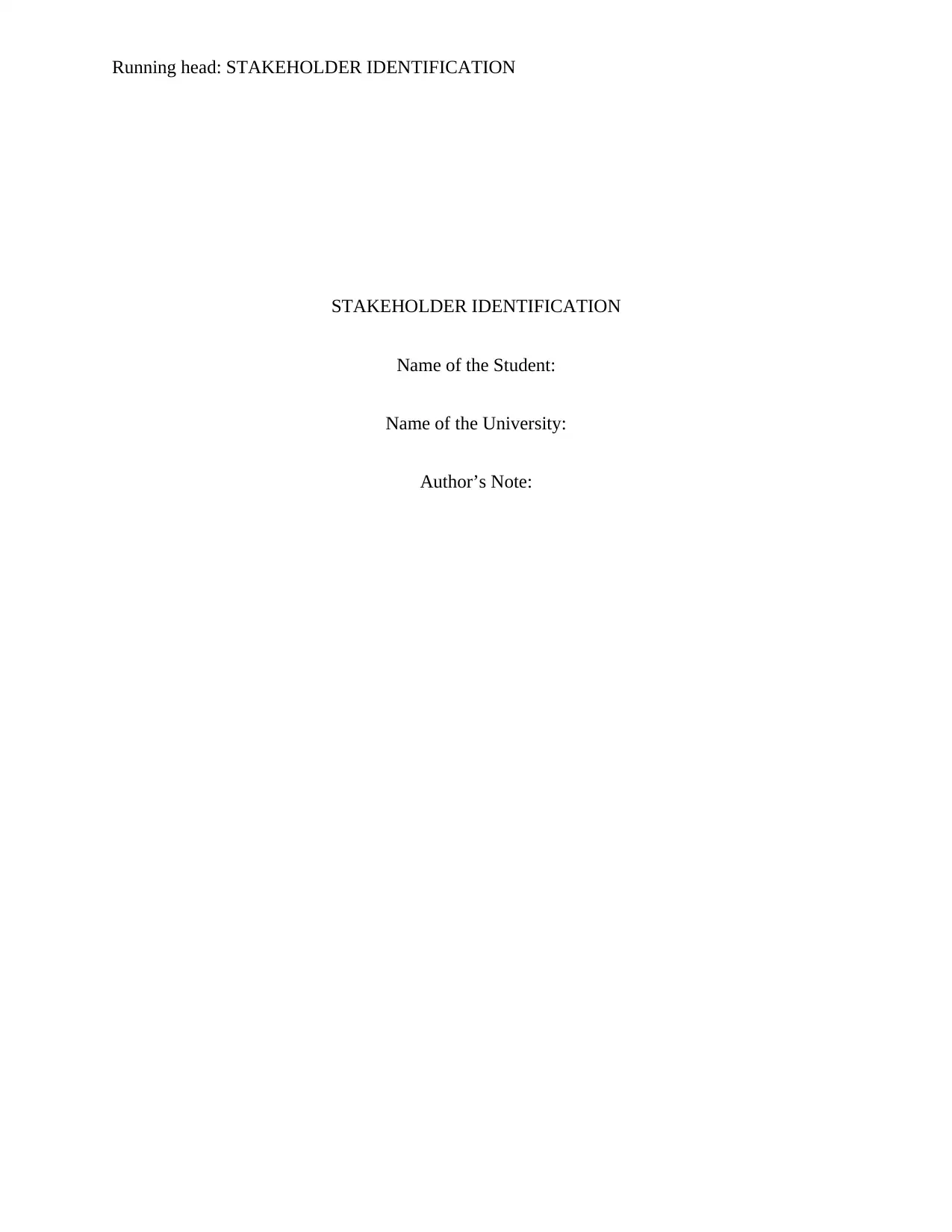
Running head: STAKEHOLDER IDENTIFICATION
STAKEHOLDER IDENTIFICATION
Name of the Student:
Name of the University:
Author’s Note:
STAKEHOLDER IDENTIFICATION
Name of the Student:
Name of the University:
Author’s Note:
Paraphrase This Document
Need a fresh take? Get an instant paraphrase of this document with our AI Paraphraser
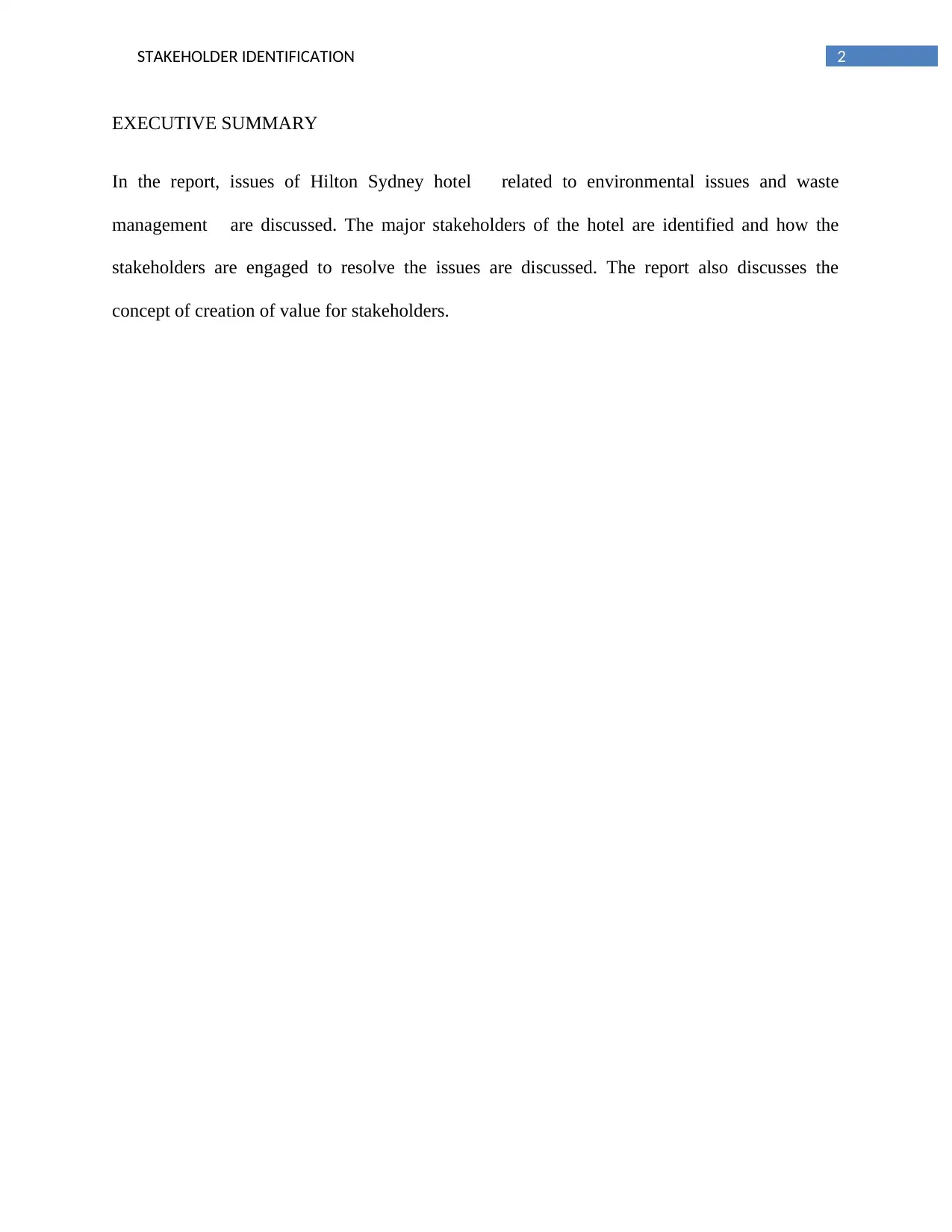
2STAKEHOLDER IDENTIFICATION
EXECUTIVE SUMMARY
In the report, issues of Hilton Sydney hotel related to environmental issues and waste
management are discussed. The major stakeholders of the hotel are identified and how the
stakeholders are engaged to resolve the issues are discussed. The report also discusses the
concept of creation of value for stakeholders.
EXECUTIVE SUMMARY
In the report, issues of Hilton Sydney hotel related to environmental issues and waste
management are discussed. The major stakeholders of the hotel are identified and how the
stakeholders are engaged to resolve the issues are discussed. The report also discusses the
concept of creation of value for stakeholders.
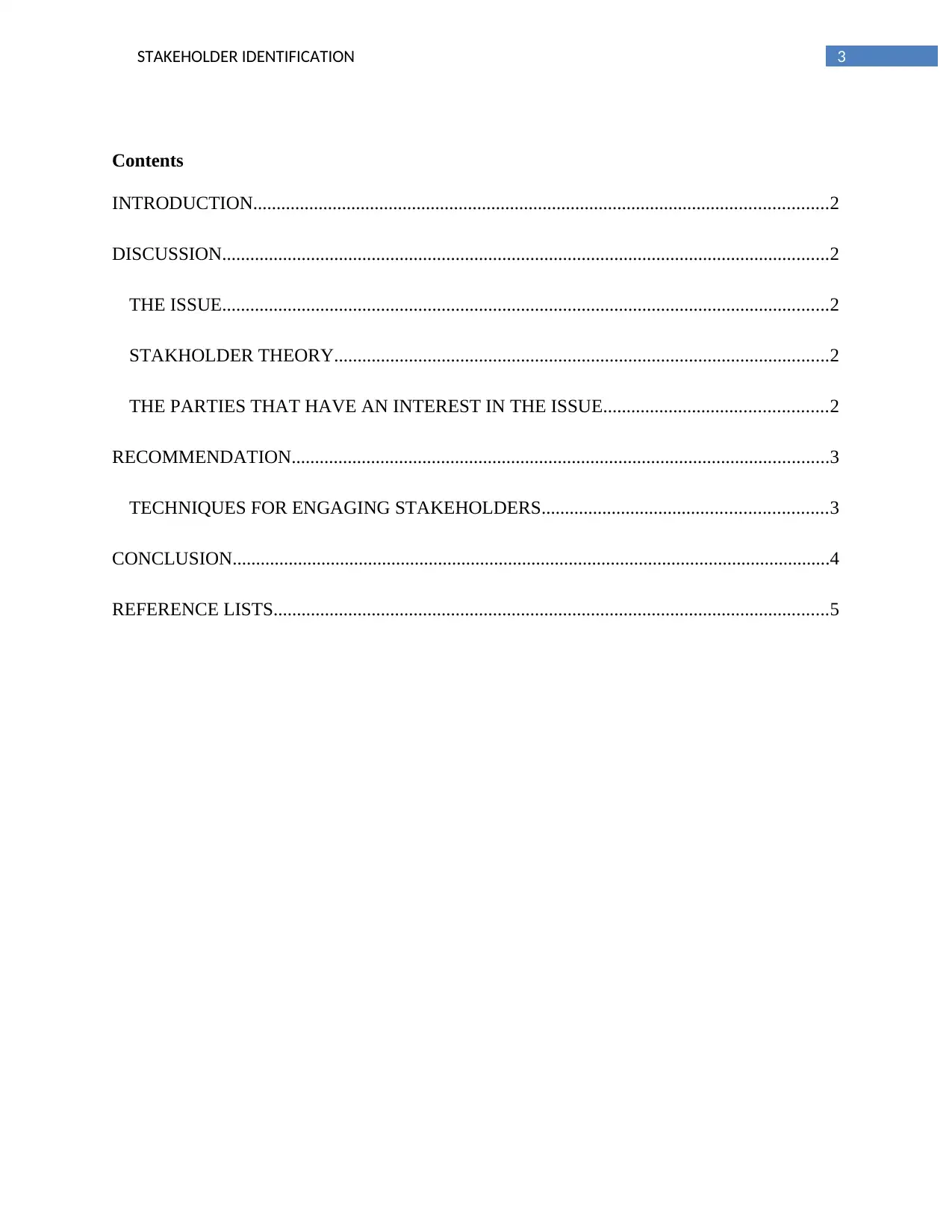
3STAKEHOLDER IDENTIFICATION
Contents
INTRODUCTION...........................................................................................................................2
DISCUSSION..................................................................................................................................2
THE ISSUE..................................................................................................................................2
STAKHOLDER THEORY..........................................................................................................2
THE PARTIES THAT HAVE AN INTEREST IN THE ISSUE................................................2
RECOMMENDATION...................................................................................................................3
TECHNIQUES FOR ENGAGING STAKEHOLDERS.............................................................3
CONCLUSION................................................................................................................................4
REFERENCE LISTS.......................................................................................................................5
Contents
INTRODUCTION...........................................................................................................................2
DISCUSSION..................................................................................................................................2
THE ISSUE..................................................................................................................................2
STAKHOLDER THEORY..........................................................................................................2
THE PARTIES THAT HAVE AN INTEREST IN THE ISSUE................................................2
RECOMMENDATION...................................................................................................................3
TECHNIQUES FOR ENGAGING STAKEHOLDERS.............................................................3
CONCLUSION................................................................................................................................4
REFERENCE LISTS.......................................................................................................................5
⊘ This is a preview!⊘
Do you want full access?
Subscribe today to unlock all pages.

Trusted by 1+ million students worldwide
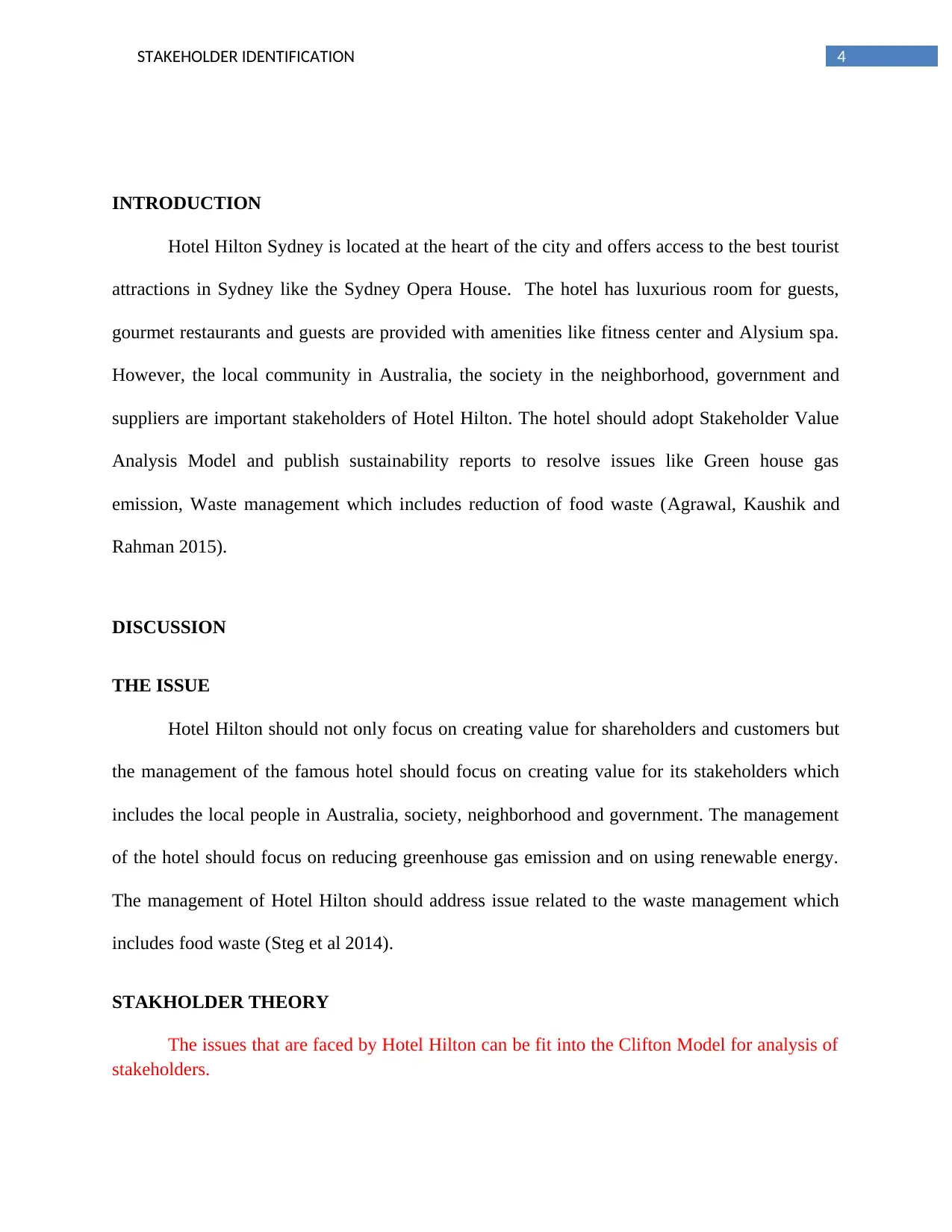
4STAKEHOLDER IDENTIFICATION
INTRODUCTION
Hotel Hilton Sydney is located at the heart of the city and offers access to the best tourist
attractions in Sydney like the Sydney Opera House. The hotel has luxurious room for guests,
gourmet restaurants and guests are provided with amenities like fitness center and Alysium spa.
However, the local community in Australia, the society in the neighborhood, government and
suppliers are important stakeholders of Hotel Hilton. The hotel should adopt Stakeholder Value
Analysis Model and publish sustainability reports to resolve issues like Green house gas
emission, Waste management which includes reduction of food waste (Agrawal, Kaushik and
Rahman 2015).
DISCUSSION
THE ISSUE
Hotel Hilton should not only focus on creating value for shareholders and customers but
the management of the famous hotel should focus on creating value for its stakeholders which
includes the local people in Australia, society, neighborhood and government. The management
of the hotel should focus on reducing greenhouse gas emission and on using renewable energy.
The management of Hotel Hilton should address issue related to the waste management which
includes food waste (Steg et al 2014).
STAKHOLDER THEORY
The issues that are faced by Hotel Hilton can be fit into the Clifton Model for analysis of
stakeholders.
INTRODUCTION
Hotel Hilton Sydney is located at the heart of the city and offers access to the best tourist
attractions in Sydney like the Sydney Opera House. The hotel has luxurious room for guests,
gourmet restaurants and guests are provided with amenities like fitness center and Alysium spa.
However, the local community in Australia, the society in the neighborhood, government and
suppliers are important stakeholders of Hotel Hilton. The hotel should adopt Stakeholder Value
Analysis Model and publish sustainability reports to resolve issues like Green house gas
emission, Waste management which includes reduction of food waste (Agrawal, Kaushik and
Rahman 2015).
DISCUSSION
THE ISSUE
Hotel Hilton should not only focus on creating value for shareholders and customers but
the management of the famous hotel should focus on creating value for its stakeholders which
includes the local people in Australia, society, neighborhood and government. The management
of the hotel should focus on reducing greenhouse gas emission and on using renewable energy.
The management of Hotel Hilton should address issue related to the waste management which
includes food waste (Steg et al 2014).
STAKHOLDER THEORY
The issues that are faced by Hotel Hilton can be fit into the Clifton Model for analysis of
stakeholders.
Paraphrase This Document
Need a fresh take? Get an instant paraphrase of this document with our AI Paraphraser
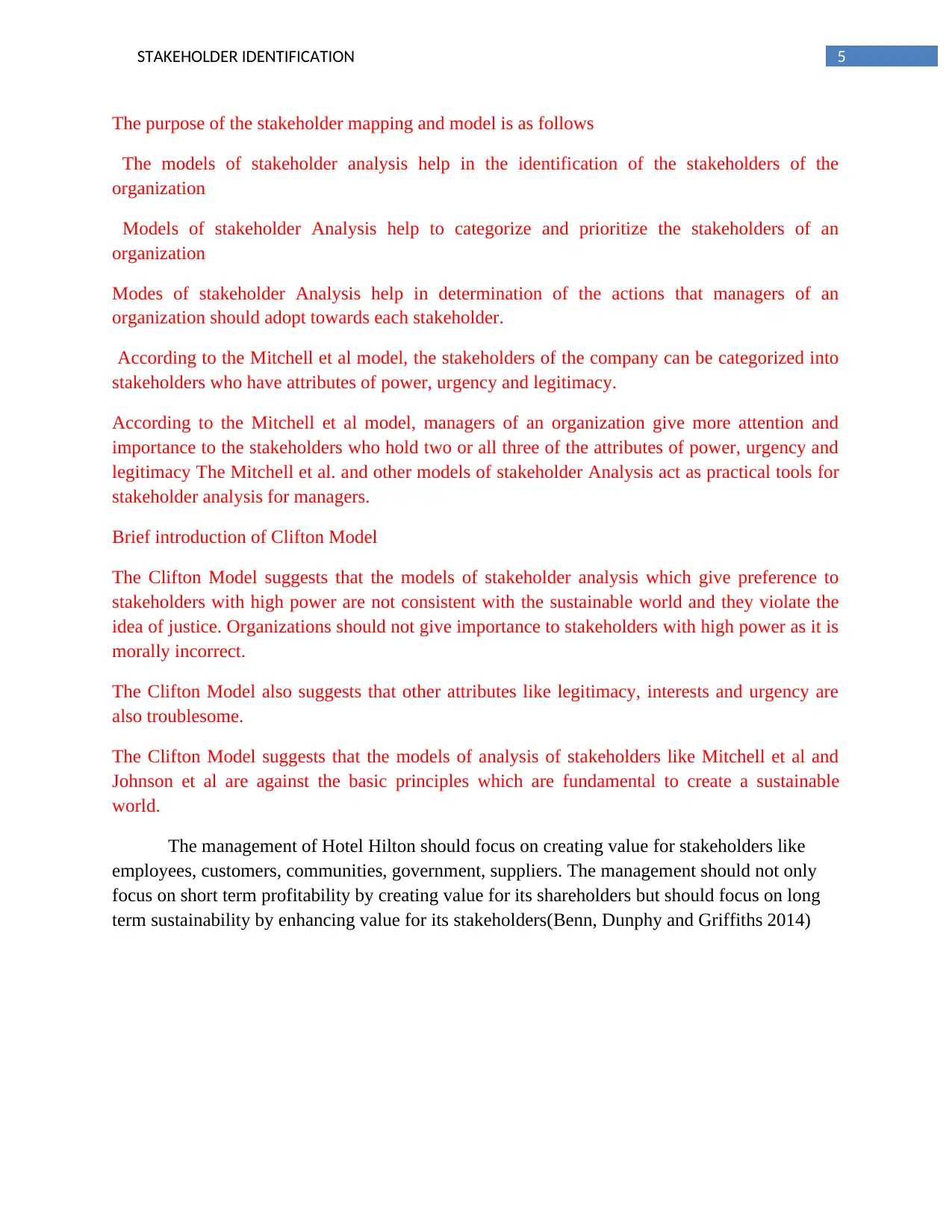
5STAKEHOLDER IDENTIFICATION
The purpose of the stakeholder mapping and model is as follows
The models of stakeholder analysis help in the identification of the stakeholders of the
organization
Models of stakeholder Analysis help to categorize and prioritize the stakeholders of an
organization
Modes of stakeholder Analysis help in determination of the actions that managers of an
organization should adopt towards each stakeholder.
According to the Mitchell et al model, the stakeholders of the company can be categorized into
stakeholders who have attributes of power, urgency and legitimacy.
According to the Mitchell et al model, managers of an organization give more attention and
importance to the stakeholders who hold two or all three of the attributes of power, urgency and
legitimacy The Mitchell et al. and other models of stakeholder Analysis act as practical tools for
stakeholder analysis for managers.
Brief introduction of Clifton Model
The Clifton Model suggests that the models of stakeholder analysis which give preference to
stakeholders with high power are not consistent with the sustainable world and they violate the
idea of justice. Organizations should not give importance to stakeholders with high power as it is
morally incorrect.
The Clifton Model also suggests that other attributes like legitimacy, interests and urgency are
also troublesome.
The Clifton Model suggests that the models of analysis of stakeholders like Mitchell et al and
Johnson et al are against the basic principles which are fundamental to create a sustainable
world.
The management of Hotel Hilton should focus on creating value for stakeholders like
employees, customers, communities, government, suppliers. The management should not only
focus on short term profitability by creating value for its shareholders but should focus on long
term sustainability by enhancing value for its stakeholders(Benn, Dunphy and Griffiths 2014)
The purpose of the stakeholder mapping and model is as follows
The models of stakeholder analysis help in the identification of the stakeholders of the
organization
Models of stakeholder Analysis help to categorize and prioritize the stakeholders of an
organization
Modes of stakeholder Analysis help in determination of the actions that managers of an
organization should adopt towards each stakeholder.
According to the Mitchell et al model, the stakeholders of the company can be categorized into
stakeholders who have attributes of power, urgency and legitimacy.
According to the Mitchell et al model, managers of an organization give more attention and
importance to the stakeholders who hold two or all three of the attributes of power, urgency and
legitimacy The Mitchell et al. and other models of stakeholder Analysis act as practical tools for
stakeholder analysis for managers.
Brief introduction of Clifton Model
The Clifton Model suggests that the models of stakeholder analysis which give preference to
stakeholders with high power are not consistent with the sustainable world and they violate the
idea of justice. Organizations should not give importance to stakeholders with high power as it is
morally incorrect.
The Clifton Model also suggests that other attributes like legitimacy, interests and urgency are
also troublesome.
The Clifton Model suggests that the models of analysis of stakeholders like Mitchell et al and
Johnson et al are against the basic principles which are fundamental to create a sustainable
world.
The management of Hotel Hilton should focus on creating value for stakeholders like
employees, customers, communities, government, suppliers. The management should not only
focus on short term profitability by creating value for its shareholders but should focus on long
term sustainability by enhancing value for its stakeholders(Benn, Dunphy and Griffiths 2014)
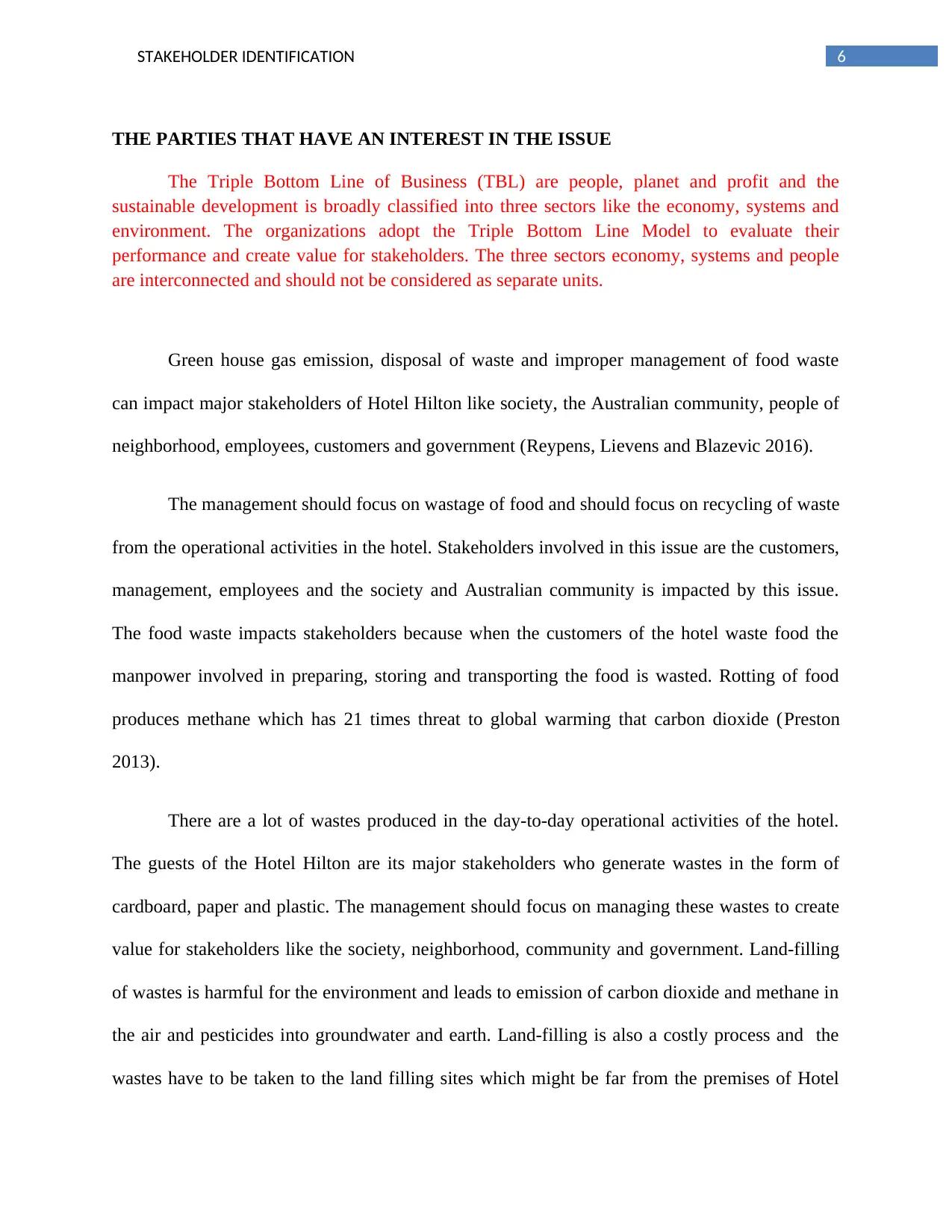
6STAKEHOLDER IDENTIFICATION
THE PARTIES THAT HAVE AN INTEREST IN THE ISSUE
The Triple Bottom Line of Business (TBL) are people, planet and profit and the
sustainable development is broadly classified into three sectors like the economy, systems and
environment. The organizations adopt the Triple Bottom Line Model to evaluate their
performance and create value for stakeholders. The three sectors economy, systems and people
are interconnected and should not be considered as separate units.
Green house gas emission, disposal of waste and improper management of food waste
can impact major stakeholders of Hotel Hilton like society, the Australian community, people of
neighborhood, employees, customers and government (Reypens, Lievens and Blazevic 2016).
The management should focus on wastage of food and should focus on recycling of waste
from the operational activities in the hotel. Stakeholders involved in this issue are the customers,
management, employees and the society and Australian community is impacted by this issue.
The food waste impacts stakeholders because when the customers of the hotel waste food the
manpower involved in preparing, storing and transporting the food is wasted. Rotting of food
produces methane which has 21 times threat to global warming that carbon dioxide (Preston
2013).
There are a lot of wastes produced in the day-to-day operational activities of the hotel.
The guests of the Hotel Hilton are its major stakeholders who generate wastes in the form of
cardboard, paper and plastic. The management should focus on managing these wastes to create
value for stakeholders like the society, neighborhood, community and government. Land-filling
of wastes is harmful for the environment and leads to emission of carbon dioxide and methane in
the air and pesticides into groundwater and earth. Land-filling is also a costly process and the
wastes have to be taken to the land filling sites which might be far from the premises of Hotel
THE PARTIES THAT HAVE AN INTEREST IN THE ISSUE
The Triple Bottom Line of Business (TBL) are people, planet and profit and the
sustainable development is broadly classified into three sectors like the economy, systems and
environment. The organizations adopt the Triple Bottom Line Model to evaluate their
performance and create value for stakeholders. The three sectors economy, systems and people
are interconnected and should not be considered as separate units.
Green house gas emission, disposal of waste and improper management of food waste
can impact major stakeholders of Hotel Hilton like society, the Australian community, people of
neighborhood, employees, customers and government (Reypens, Lievens and Blazevic 2016).
The management should focus on wastage of food and should focus on recycling of waste
from the operational activities in the hotel. Stakeholders involved in this issue are the customers,
management, employees and the society and Australian community is impacted by this issue.
The food waste impacts stakeholders because when the customers of the hotel waste food the
manpower involved in preparing, storing and transporting the food is wasted. Rotting of food
produces methane which has 21 times threat to global warming that carbon dioxide (Preston
2013).
There are a lot of wastes produced in the day-to-day operational activities of the hotel.
The guests of the Hotel Hilton are its major stakeholders who generate wastes in the form of
cardboard, paper and plastic. The management should focus on managing these wastes to create
value for stakeholders like the society, neighborhood, community and government. Land-filling
of wastes is harmful for the environment and leads to emission of carbon dioxide and methane in
the air and pesticides into groundwater and earth. Land-filling is also a costly process and the
wastes have to be taken to the land filling sites which might be far from the premises of Hotel
⊘ This is a preview!⊘
Do you want full access?
Subscribe today to unlock all pages.

Trusted by 1+ million students worldwide
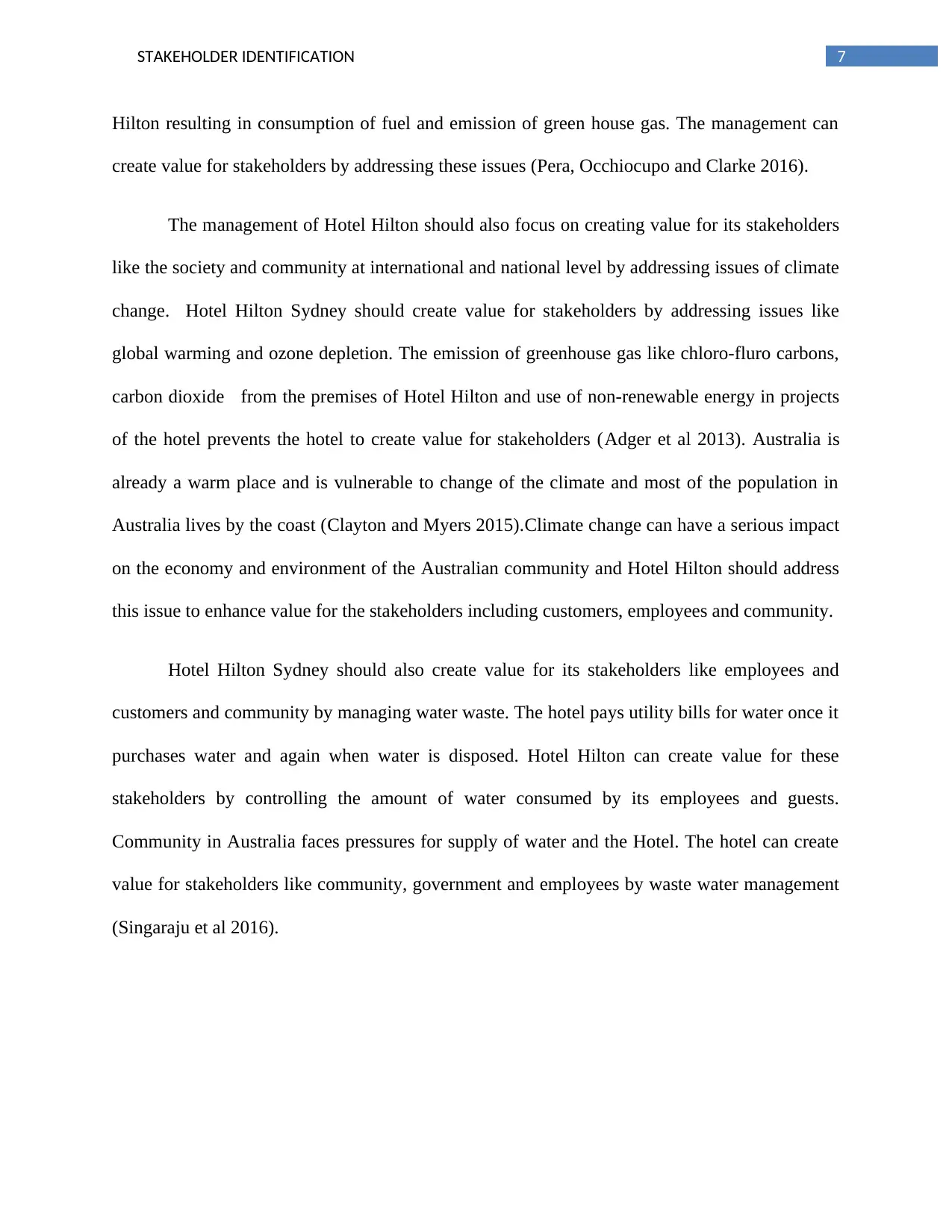
7STAKEHOLDER IDENTIFICATION
Hilton resulting in consumption of fuel and emission of green house gas. The management can
create value for stakeholders by addressing these issues (Pera, Occhiocupo and Clarke 2016).
The management of Hotel Hilton should also focus on creating value for its stakeholders
like the society and community at international and national level by addressing issues of climate
change. Hotel Hilton Sydney should create value for stakeholders by addressing issues like
global warming and ozone depletion. The emission of greenhouse gas like chloro-fluro carbons,
carbon dioxide from the premises of Hotel Hilton and use of non-renewable energy in projects
of the hotel prevents the hotel to create value for stakeholders (Adger et al 2013). Australia is
already a warm place and is vulnerable to change of the climate and most of the population in
Australia lives by the coast (Clayton and Myers 2015).Climate change can have a serious impact
on the economy and environment of the Australian community and Hotel Hilton should address
this issue to enhance value for the stakeholders including customers, employees and community.
Hotel Hilton Sydney should also create value for its stakeholders like employees and
customers and community by managing water waste. The hotel pays utility bills for water once it
purchases water and again when water is disposed. Hotel Hilton can create value for these
stakeholders by controlling the amount of water consumed by its employees and guests.
Community in Australia faces pressures for supply of water and the Hotel. The hotel can create
value for stakeholders like community, government and employees by waste water management
(Singaraju et al 2016).
Hilton resulting in consumption of fuel and emission of green house gas. The management can
create value for stakeholders by addressing these issues (Pera, Occhiocupo and Clarke 2016).
The management of Hotel Hilton should also focus on creating value for its stakeholders
like the society and community at international and national level by addressing issues of climate
change. Hotel Hilton Sydney should create value for stakeholders by addressing issues like
global warming and ozone depletion. The emission of greenhouse gas like chloro-fluro carbons,
carbon dioxide from the premises of Hotel Hilton and use of non-renewable energy in projects
of the hotel prevents the hotel to create value for stakeholders (Adger et al 2013). Australia is
already a warm place and is vulnerable to change of the climate and most of the population in
Australia lives by the coast (Clayton and Myers 2015).Climate change can have a serious impact
on the economy and environment of the Australian community and Hotel Hilton should address
this issue to enhance value for the stakeholders including customers, employees and community.
Hotel Hilton Sydney should also create value for its stakeholders like employees and
customers and community by managing water waste. The hotel pays utility bills for water once it
purchases water and again when water is disposed. Hotel Hilton can create value for these
stakeholders by controlling the amount of water consumed by its employees and guests.
Community in Australia faces pressures for supply of water and the Hotel. The hotel can create
value for stakeholders like community, government and employees by waste water management
(Singaraju et al 2016).
Paraphrase This Document
Need a fresh take? Get an instant paraphrase of this document with our AI Paraphraser
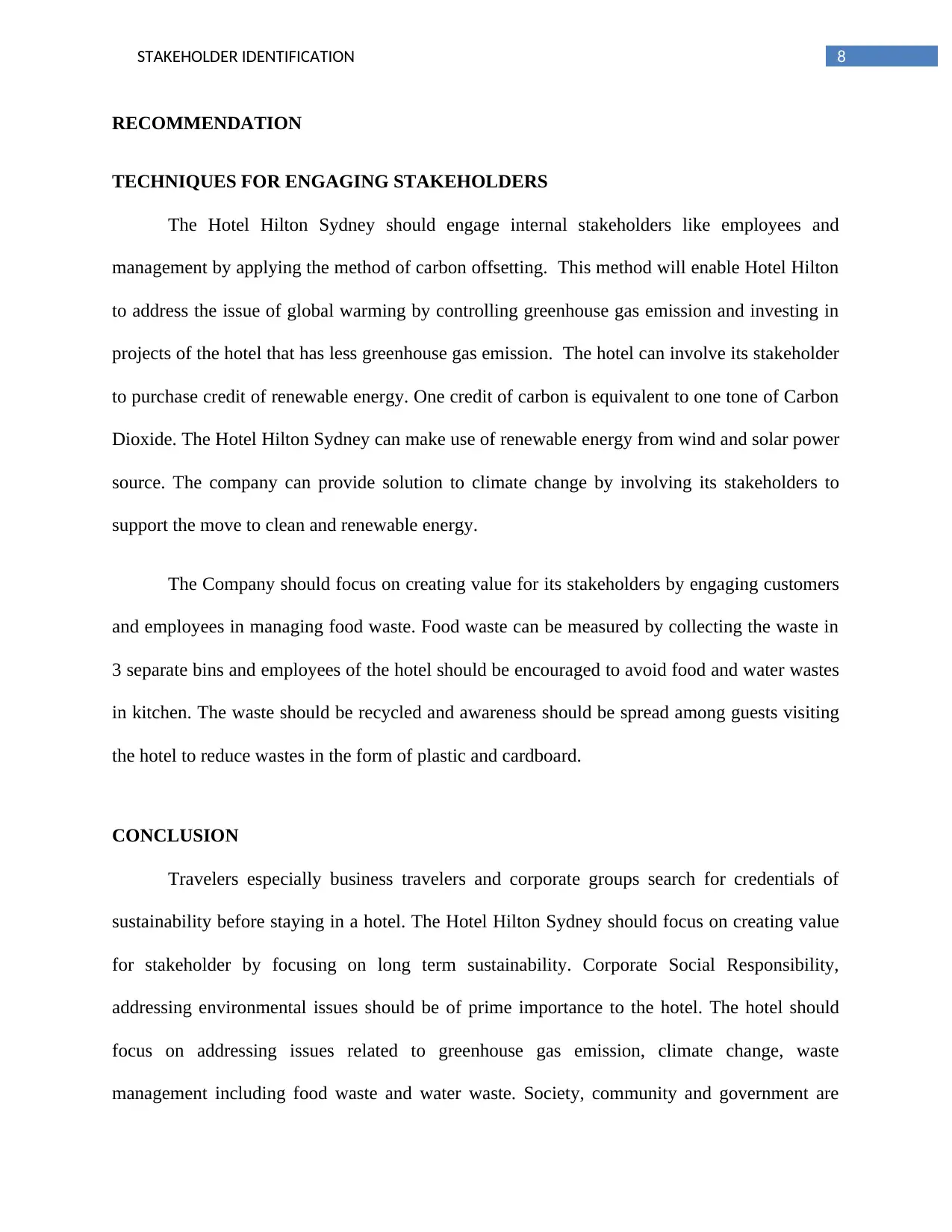
8STAKEHOLDER IDENTIFICATION
RECOMMENDATION
TECHNIQUES FOR ENGAGING STAKEHOLDERS
The Hotel Hilton Sydney should engage internal stakeholders like employees and
management by applying the method of carbon offsetting. This method will enable Hotel Hilton
to address the issue of global warming by controlling greenhouse gas emission and investing in
projects of the hotel that has less greenhouse gas emission. The hotel can involve its stakeholder
to purchase credit of renewable energy. One credit of carbon is equivalent to one tone of Carbon
Dioxide. The Hotel Hilton Sydney can make use of renewable energy from wind and solar power
source. The company can provide solution to climate change by involving its stakeholders to
support the move to clean and renewable energy.
The Company should focus on creating value for its stakeholders by engaging customers
and employees in managing food waste. Food waste can be measured by collecting the waste in
3 separate bins and employees of the hotel should be encouraged to avoid food and water wastes
in kitchen. The waste should be recycled and awareness should be spread among guests visiting
the hotel to reduce wastes in the form of plastic and cardboard.
CONCLUSION
Travelers especially business travelers and corporate groups search for credentials of
sustainability before staying in a hotel. The Hotel Hilton Sydney should focus on creating value
for stakeholder by focusing on long term sustainability. Corporate Social Responsibility,
addressing environmental issues should be of prime importance to the hotel. The hotel should
focus on addressing issues related to greenhouse gas emission, climate change, waste
management including food waste and water waste. Society, community and government are
RECOMMENDATION
TECHNIQUES FOR ENGAGING STAKEHOLDERS
The Hotel Hilton Sydney should engage internal stakeholders like employees and
management by applying the method of carbon offsetting. This method will enable Hotel Hilton
to address the issue of global warming by controlling greenhouse gas emission and investing in
projects of the hotel that has less greenhouse gas emission. The hotel can involve its stakeholder
to purchase credit of renewable energy. One credit of carbon is equivalent to one tone of Carbon
Dioxide. The Hotel Hilton Sydney can make use of renewable energy from wind and solar power
source. The company can provide solution to climate change by involving its stakeholders to
support the move to clean and renewable energy.
The Company should focus on creating value for its stakeholders by engaging customers
and employees in managing food waste. Food waste can be measured by collecting the waste in
3 separate bins and employees of the hotel should be encouraged to avoid food and water wastes
in kitchen. The waste should be recycled and awareness should be spread among guests visiting
the hotel to reduce wastes in the form of plastic and cardboard.
CONCLUSION
Travelers especially business travelers and corporate groups search for credentials of
sustainability before staying in a hotel. The Hotel Hilton Sydney should focus on creating value
for stakeholder by focusing on long term sustainability. Corporate Social Responsibility,
addressing environmental issues should be of prime importance to the hotel. The hotel should
focus on addressing issues related to greenhouse gas emission, climate change, waste
management including food waste and water waste. Society, community and government are

9STAKEHOLDER IDENTIFICATION
important stakeholders of Hotel Hilton and thus the hotel should not only focus on creating
profitability for shareholders but should also create value for its stakeholders by addressing
issues of environment and climate change.
important stakeholders of Hotel Hilton and thus the hotel should not only focus on creating
profitability for shareholders but should also create value for its stakeholders by addressing
issues of environment and climate change.
⊘ This is a preview!⊘
Do you want full access?
Subscribe today to unlock all pages.

Trusted by 1+ million students worldwide
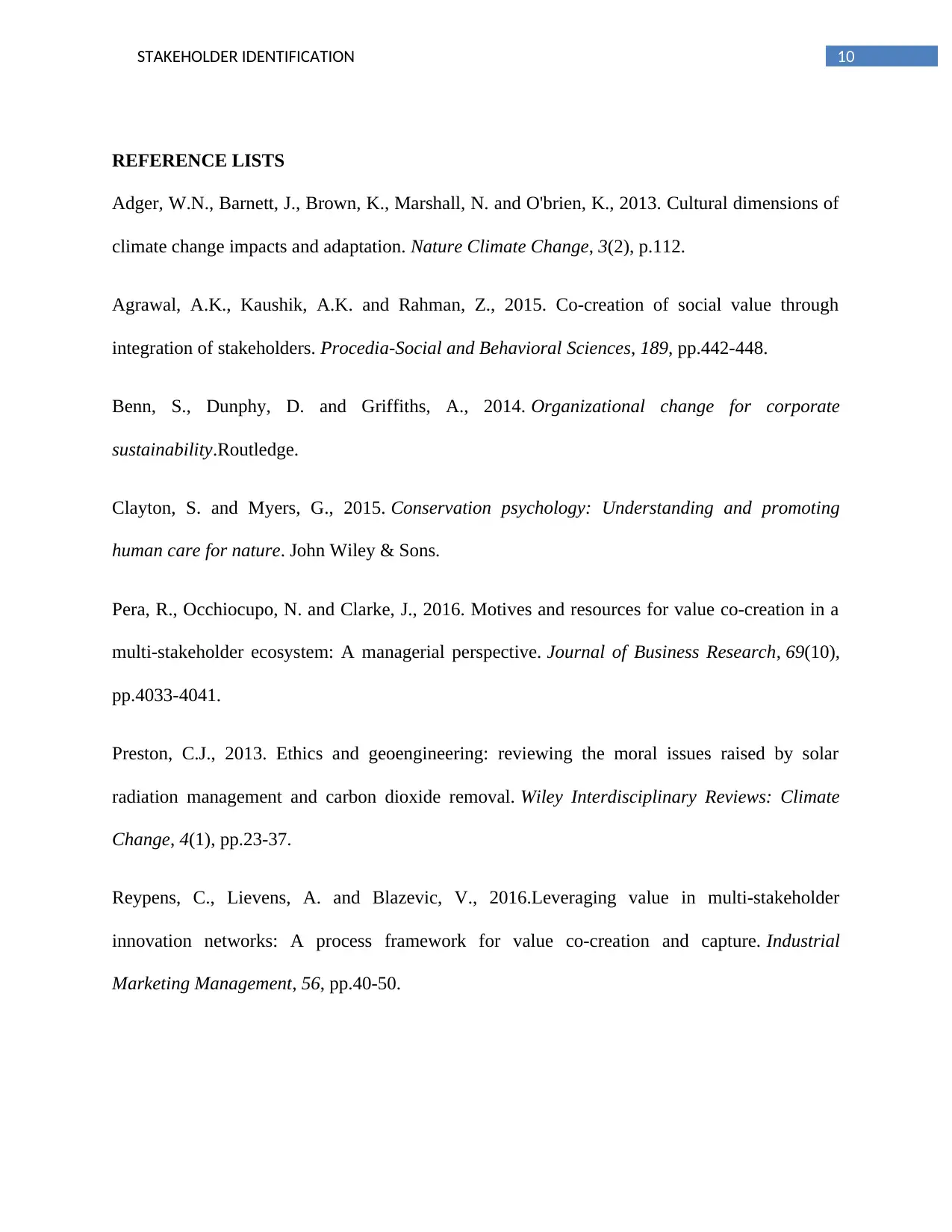
10STAKEHOLDER IDENTIFICATION
REFERENCE LISTS
Adger, W.N., Barnett, J., Brown, K., Marshall, N. and O'brien, K., 2013. Cultural dimensions of
climate change impacts and adaptation. Nature Climate Change, 3(2), p.112.
Agrawal, A.K., Kaushik, A.K. and Rahman, Z., 2015. Co-creation of social value through
integration of stakeholders. Procedia-Social and Behavioral Sciences, 189, pp.442-448.
Benn, S., Dunphy, D. and Griffiths, A., 2014. Organizational change for corporate
sustainability.Routledge.
Clayton, S. and Myers, G., 2015. Conservation psychology: Understanding and promoting
human care for nature. John Wiley & Sons.
Pera, R., Occhiocupo, N. and Clarke, J., 2016. Motives and resources for value co-creation in a
multi-stakeholder ecosystem: A managerial perspective. Journal of Business Research, 69(10),
pp.4033-4041.
Preston, C.J., 2013. Ethics and geoengineering: reviewing the moral issues raised by solar
radiation management and carbon dioxide removal. Wiley Interdisciplinary Reviews: Climate
Change, 4(1), pp.23-37.
Reypens, C., Lievens, A. and Blazevic, V., 2016.Leveraging value in multi-stakeholder
innovation networks: A process framework for value co-creation and capture. Industrial
Marketing Management, 56, pp.40-50.
REFERENCE LISTS
Adger, W.N., Barnett, J., Brown, K., Marshall, N. and O'brien, K., 2013. Cultural dimensions of
climate change impacts and adaptation. Nature Climate Change, 3(2), p.112.
Agrawal, A.K., Kaushik, A.K. and Rahman, Z., 2015. Co-creation of social value through
integration of stakeholders. Procedia-Social and Behavioral Sciences, 189, pp.442-448.
Benn, S., Dunphy, D. and Griffiths, A., 2014. Organizational change for corporate
sustainability.Routledge.
Clayton, S. and Myers, G., 2015. Conservation psychology: Understanding and promoting
human care for nature. John Wiley & Sons.
Pera, R., Occhiocupo, N. and Clarke, J., 2016. Motives and resources for value co-creation in a
multi-stakeholder ecosystem: A managerial perspective. Journal of Business Research, 69(10),
pp.4033-4041.
Preston, C.J., 2013. Ethics and geoengineering: reviewing the moral issues raised by solar
radiation management and carbon dioxide removal. Wiley Interdisciplinary Reviews: Climate
Change, 4(1), pp.23-37.
Reypens, C., Lievens, A. and Blazevic, V., 2016.Leveraging value in multi-stakeholder
innovation networks: A process framework for value co-creation and capture. Industrial
Marketing Management, 56, pp.40-50.
Paraphrase This Document
Need a fresh take? Get an instant paraphrase of this document with our AI Paraphraser
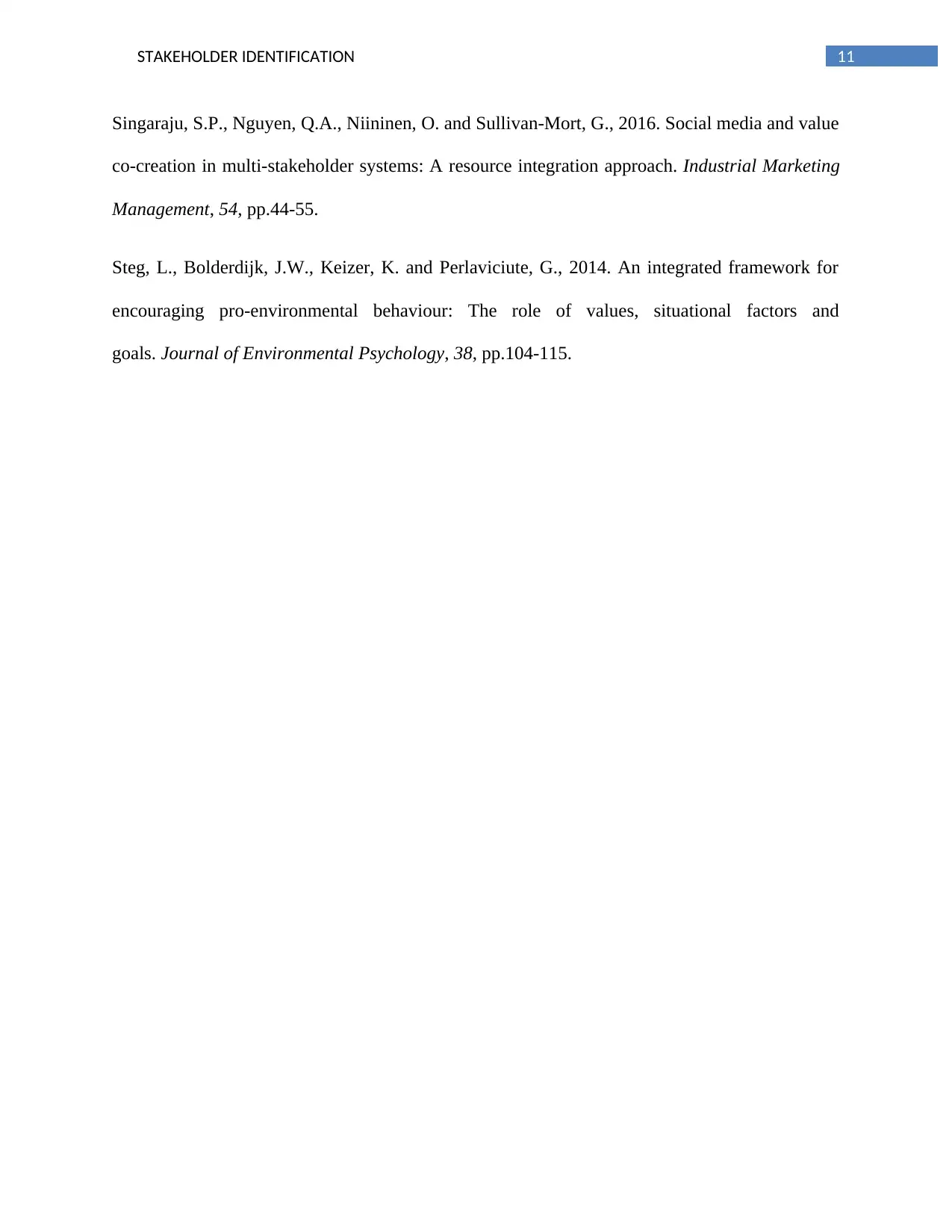
11STAKEHOLDER IDENTIFICATION
Singaraju, S.P., Nguyen, Q.A., Niininen, O. and Sullivan-Mort, G., 2016. Social media and value
co-creation in multi-stakeholder systems: A resource integration approach. Industrial Marketing
Management, 54, pp.44-55.
Steg, L., Bolderdijk, J.W., Keizer, K. and Perlaviciute, G., 2014. An integrated framework for
encouraging pro-environmental behaviour: The role of values, situational factors and
goals. Journal of Environmental Psychology, 38, pp.104-115.
Singaraju, S.P., Nguyen, Q.A., Niininen, O. and Sullivan-Mort, G., 2016. Social media and value
co-creation in multi-stakeholder systems: A resource integration approach. Industrial Marketing
Management, 54, pp.44-55.
Steg, L., Bolderdijk, J.W., Keizer, K. and Perlaviciute, G., 2014. An integrated framework for
encouraging pro-environmental behaviour: The role of values, situational factors and
goals. Journal of Environmental Psychology, 38, pp.104-115.
1 out of 11
Related Documents
Your All-in-One AI-Powered Toolkit for Academic Success.
+13062052269
info@desklib.com
Available 24*7 on WhatsApp / Email
![[object Object]](/_next/static/media/star-bottom.7253800d.svg)
Unlock your academic potential
Copyright © 2020–2025 A2Z Services. All Rights Reserved. Developed and managed by ZUCOL.





